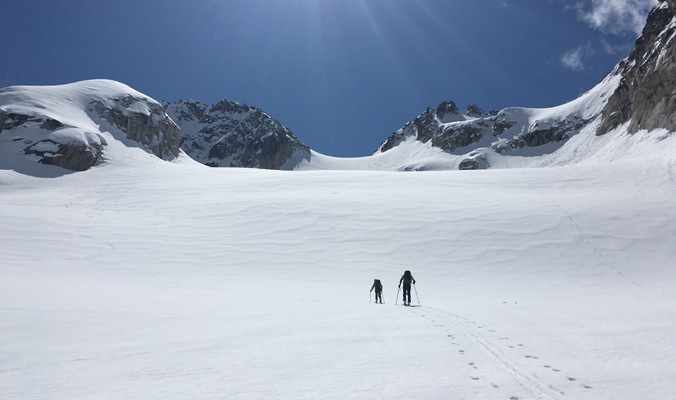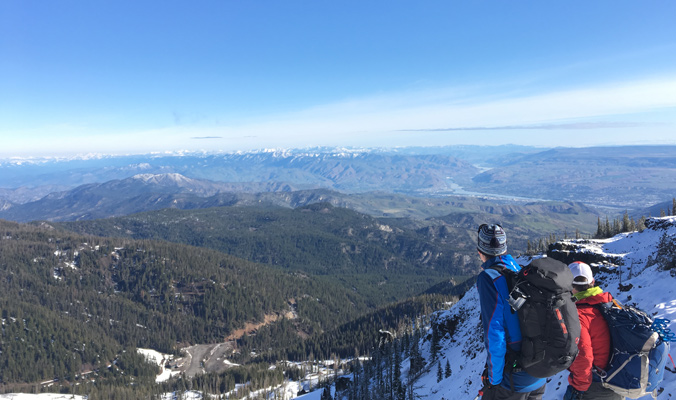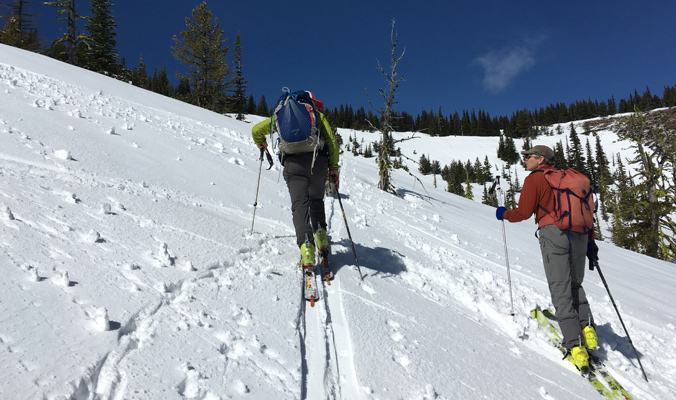
Mike Rolfs and Coron Polley ascending Silver Star Peak. | North Cascades, Washington | Photo: Lucy Higgins
Last winter in Lake Tahoe, Calif. broke records—and not in the way that skiers prefer. But what’s really stressing them out more than disappearing snow? Disappearing parking spaces.
In an effort to decrease sediment runoff into Lake Tahoe, the California Department of Transportation (Caltrans) spent the summer narrowing the edges of Highway 89 in Tahoe’s West Shore Region and, in doing so, knocked out many unofficial backcountry parking spots and pullovers. Unlike last season’s weather, this dilemma is something skiers and riders can actually do something about.
“As soon as the Caltrans paving project was noticeably taking away parking, the backcountry skiers almost pushed us into action,” says Rich Meyer, a founder of the Tahoe Backcountry Alliance, which banded together in October in response to the parking predicament. “We had an issue that everyone could rally around. The parking issue was a perfect catalyst to kick start our group.”
The Tahoe Regional Transit Authority quickly responded to the inundation of letters, e-mails and phone calls, creating new paved parking zones like the one in Lake Tahoe’s West Shore for the popular Jakes Peak zone.
This isn’t the first time a group of backcountry skiers and riders has spoken up about access to their favorite zones. In 2013, when Canadian real-estate developer Taliskier Mountain Inc. proposed a gondola that would connect Utah’s Canyons to Solitude Mountain Resorts, Wasatch skiers took note. They organized to form the Wasatch Backcountry Alliance (WBA) and have since advocated for access and lobbied against development in Utah’s mountains.
“People like the wild feel that we still have [in the Wasatch],” says Jamie Kent, president of WBA. “We started Wasatch Backcountry Alliance to be a unified voice and to be the go-to organization for any policy makers and for anyone who needed a better understanding for what we have here and what’s important for us.”
That trend of forming community organizations is one that’s catching on nationwide. From California to Washington, through Colorado and Utah and all the way to Vermont, alliances are taking hold, organizing backcountry users around grassroots advocacy.
The El Sendero Backcountry Ski and Snowshoe Club is one longstanding example, founded by Gus Bekker in Wenatchee, Wash., just outside the Wenatchee Mountain subrange of the Cascades, in 2004. Ever since, El Sendero has tackled the issue of motorized versus human-powered land use in the nearby Okanogan-Wenatchee National Forest and public, state land.
“The snowmobile use impacted where the skiers went. We tried to use some of the same areas, but we quickly found out that the snowmobilers were a lot faster and lot more powerful,” Bekker says of the conflict that sprung him into action. “Our group would go to the Forest Service and express our frustrations of [them] not actively managing the forest.”

Lowell Skoog and Mike Rolfs survey Mission Ridge Resort and the adjacent backcountry terrain. | Wenatchee, Washington | Photo: Lucy Higgins
Bekker and El Sendero’s board of directors, on behalf of the 250 members, spent two years working with the Washington Department of Natural Resources, the Fish and Wildlife Department and other recreationalists, from mountain bikers to backcountry horsemen, to establish a parcel of public land for non-motorized use.
In January 2015, the plan was approved, and 4,000 acres in the Stemilt Basin, 10 miles south of Wenatchee and east of Mission Ridge Ski and Board Resort, are now set aside for human-powered use. That acreage is part of the larger, 230,000-acre Naneum Ridge to Columbia River Recreation and Access Plan. “It’s plenty big enough for us to enjoy,” Bekker says of their allocated space. “What we really wanted was for us to have a quiet, backcountry, remote area to go skiing.”
Perhaps just as importantly, El Sendero can contribute to additional land-use decisions, including the placement of mountain-bike trails and designating space for snowmobile use. Through the alliance, backcountry skiers and riders now find themselves seated at the decision-making table alongside other organized stakeholders.
And as more members of the regional communities begin organizing themselves into alliances, their advocacy takes a larger scope. El Sendero and the Wasatch Backcountry Alliance, along with more than 30 other bc-specific organizations, align themselves with the Winter Wildlands Alliance (WWA). The national organization aims to defend and promote winter, human-powered experiences on public lands by working with regional alliance to create cohesive programs and missions.
In 2000, WWA formed out of three regional groups—Idaho’s Nordic Backcountry Skiers Alliance, California’s Snowlands Network and Colorado’s Backcountry Ski Alliance, now known as the Colorado Mountain Club.
“Those groups got together and said we need a national group that can serve as a mentor and really keep abreast of these bigger trends and also help us at the local level to work on our local issues,” Mark Menlove, WWA’s Executive Director, says of the organization’s beginnings. “Now we have 35 grassroots groups working at the local level.”
WWA provides those affiliated groups with fundraising and learning opportunities, including a chance to host their own Backcountry Film Festival and to participate in their annual Grassroots Advocacy Conference, where they share information on policies, networking and current land-use issues.

Mike Rolfs and Andy Dappen, El Sendero board members, chat as they skin up Stemilt Basin. | Wenatchee, Washington | Photo: Lucy Higgins
For alliances just starting out, like the Vermont Backcountry Alliance (VTBC), having a national affiliation, while also partnering with local organizations, like central Vermont’s Rochester Area Sports Trail Alliance (RASTA) and the statewide Catamount Trail Association, gives momentum to discussions already occurring.
“Over the last 10 to 15 years, backcountry skiers and riders throughout the state were having the same conversation [on access],” VTBC co-founder Brian Mohr says. “Then a local group of folks in central Vermont that are the core of RASTA organized the first forum in the fall of 2013.” That forum, held each fall since, gathers roughly 200 people to discuss ethics, land use, conservation and new trails.
While the Wasatch Backcountry Alliance and El Sendero arose from specific threats to access, VTBC is looking to establish itself as a community resource before such conflicts arise. “There’s no real problem right now in Vermont,” Mohr says. “A lot of the landscapes that we play in in the northeast are privately held but publicly accessible, and that’s part of the spirit of Vermonters.”
“As the sport grows, we want to make sure we’re ahead of the game as a community,” Mohr continues, “ensuring that we can continue having those relationships with landowners and build on them, whether it’s a hut system or locally managed terrain.”
Jamie Kent, of WBA, echoes Mohr’s sentiments, suggesting that emerging alliances focus on strengthening relationships, whether with mechanized users, landowners or policymakers. “When it comes down to forming public policy and protecting these places, it’s important to have a widespread public sphere to influence the policy makers, from town, city, state, even to national levels,” Kent says. “Most people really care about the mountains. They like knowing that it’s there, that it will be there, and that it’s protected.”
For Bekker, that community awareness and appreciation is fostered through El Sendero’s annual Backcountry Film Festival, which they’ve hosted each December for nine years.
“It’s helped build a community of 200 to 300 people who enjoy winter recreation,” Bekker says. “They all come out of the woods, and we all get together and celebrate. There are groups all over the U.S. that do the same thing. It brings us out of the basement, away from waxing skis and drinking beer.”
—
To get the February issue, visit the Backcountry Magazine store.










Snowlands Network, founded in 2001, advocates for human-powered winter recreation and increased access in a dozen national forests in the Sierra Nevada and southern Cascades. Our efforts were instrumental in forcing Region 5 of the Forest Service recently to undertake a reconsideration of winter recreation opportunity. We have earned more than a passing mention in your article. This is important to the cause because we have in the last year proposed planning initiatives in six national forests in California and Nevada and need the public’s support for these initiatives, which improve human-powered winter recreation opportunity. This is the most active and important area of advocacy under the new winter travel planning rule and it is happening NOW. Our extensive efforts are documented on our website, http://www.snowlands.org.
Bob Rowen
Chairman, Snowlands Network